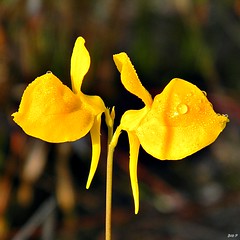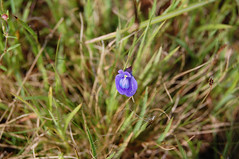Bladderwort – An Aquatic Carnivorous Plant
Bladderwort or Utricularia is a genus of carnivorous plants that live in wet soil and fresh water. The name is taken from their traps that resemble the bladder. These traps help nourish the plant by capturing small organisms such as rotifers and protozoa.

Bladderworts, Horned bladderwort Utricularia cornuta—bob in swamp (Flickr.com)
Despite being small, bladderwort’s ultra fast trap is considered to be highly sophisticated. The trapdoor reacts to movements that brush against the trigger hairs. Before feeding, the bladder is set to negative pressure. When the trapdoor is triggered, the prey along with a certain amount of water that surround it are absorbed into the bladder. The bladder then closes once it is filled with water.
The astounding part is that the entire feeding process takes only about 15,000th of a second. In fact, observing the process in the microscope requires extreme slow motion so that it becomes visible. Indeed, [pullquote]Bladderworts are one of the most interesting carnivorous plants that nature has created.[/pullquote]
These specialized plants are angiosperms meaning their vegetative organs are almost identifiable with the stems, leaves, and roots. They grow as wide as 2mm – 10 cm and can survive in any areas with fresh water in most parts of the year.
All these facts show that Bladderworts are among nature’s most mesmerizing creations. Unlike other plants that seek nourishment from the sun, Bladderworts trap small organisms to survive. This makes them carnivorous unlike the huge percentage of species in the kingdom plantae.

Bladderworts, Purple Bladderwort—jayeshp912 (Flickr.com)
The more interesting part is its trapping mechanism is unique even when compared to other carnivorous plants. There are those that use acid to lure and digest their prey. Others use specialized trapping mechanisms wherein the prey lands unsuspectingly on the plant where it is then trapped and digested.
Bladderworts, on the other hand, have transparent and very thin walls. However, these walls are inflexible enough to maintain its shape despite the vacuum created to absorb preys. Its trapping mechanism does not involve irritability similar to Venus Flytraps. The only mechanism involved in the feeding process is the pumping of water to create partial vacuum.
These aquatic carnivores are fascinating. For a plant so small to have such a sophisticated feeding method is something that only nature can create. Understanding these plants can help their preservation and the diversity of species that provide balance to the environment.
Filed under: Mosquito Eating Plant
Like this post? Subscribe to my RSS feed and get loads more!



Leave a Reply
You must be logged in to post a comment.